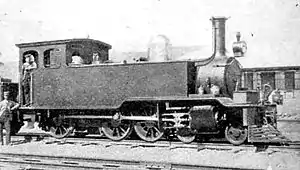| |||||||||
| Decades: |
| ||||||||
|---|---|---|---|---|---|---|---|---|---|
| See also: | |||||||||
The following lists events that happened during 1897 in South Africa.
Incumbents
- Governor of the Cape of Good Hope and High Commissioner for Southern Africa:Hercules Robinson then Alfred Milner.
- Governor of the Colony of Natal: Charles Bullen Hugh Mitchell.
- State President of the Orange Free State: Martinus Theunis Steyn.
- State President of the South African Republic: Paul Kruger.
- Prime Minister of the Cape of Good Hope: John Gordon Sprigg.
- Prime Minister of the Colony of Natal:
- until 14 February: John Robinson.
- 15 February – 4 October: Harry Escombe.
- starting 4 October: Henry Binns.
Events
- April
- 21 – Sir Alfred Milner becomes High Commissioner of South Africa and Governor of the Cape Colony.
- May
- 5 – Port Elizabeth is flooded.
- December
- 30 – The Colony of Natal annexes Zululand.
- Unknown date
- Bergville is established in the foothills of the Drakensberg mountains in Natal.
- "Nkosi Sikelel' iAfrika" ("God Bless Africa") is composed as a Xhosa hymn by South African teacher Enoch Sontonga.
Births
- 3 July – Ludwig Wybren Hiemstra, Afrikaans linguist and editor of the Bilingual Dictionary, is born in Lydenburg.
- 26 October – James Leonard Brierley Smith, ichthyologist, is born in Graaff Reinet.
Deaths
Railways
Railway lines opened
- 13 March – Cape Western – Mafeking to Ramatlabama at the Bechuanaland border, 16 miles (25.7 kilometres).[1]
- 3 August – Transvaal – Frederikstad to Klerksdorp, 43 miles (69.2 kilometres).[1]
- 1 October – Cape Midland – Rosmead Junction to Middelburg, 7 miles 3 chains (11.3 kilometres).[2]
- 1 December – Natal – Isipingo to Park Rynie, 27 miles 48 chains (44.4 kilometres).[1]
- 3 December – Natal – Verulam to Tongaat, 12 miles (19.3 kilometres).[1]
- 15 December – Natal – Thornville Junction to Richmond, 17 miles 17 chains (27.7 kilometres).[1]
Locomotives
- Cape
Two new Cape gauge locomotive types enter service on the Cape Government Railways (CGR):
- Six 4th Class 4-4-2 Atlantic type tender locomotives on the section from Kimberley southwards.[3]
- A third batch of fifty-five 6th Class 4-6-0 steam locomotives. In 1912 they would become Class 6B on the South African Railways.[3][4][5][6]
- Transvaal
- The independent Pretoria-Pietersburg Railway in the Zuid-Afrikaansche Republiek (Transvaal Republic) purchases a 4-6-0 35 Tonner tank locomotive named Portuguese from the Lourenco Marques, Delagoa Bay and East Africa Railway in Mozambique.[3]
- Arthur Koppel, acting as agent, imports a number of Dickson-built 0-4-2ST narrow gauge saddle tank steam locomotives to mines on the Witwatersrand.[6]
References
- 1 2 3 4 5 Statement Showing, in Chronological Order, the Date of Opening and the Mileage of Each Section of Railway, Statement No. 19, p. 183, ref. no. 200954-13
- ↑ Report for year ending 31 December 1909, Cape Government Railways, Section VIII - Dates of Opening and the Length of the different Sections in the Cape Colony, from the Year 1873 to 31st December, 1909.
- 1 2 3 Holland, D.F. (1971). Steam Locomotives of the South African Railways. Vol. 1: 1859–1910 (1st ed.). Newton Abbott, England: David & Charles. pp. 46–47, 57–59, 118–119. ISBN 978-0-7153-5382-0.
- ↑ Holland, D. F. (1972). Steam Locomotives of the South African Railways. Vol. 2: 1910-1955 (1st ed.). Newton Abbott, England: David & Charles. pp. 137–138. ISBN 978-0-7153-5427-8.
- ↑ Classification of S.A.R. Engines with Renumbering Lists, issued by the Chief Mechanical Engineer’s Office, Pretoria, January 1912, pp. 8, 12, 14, 30-31 (Reprinted in April 1987 by SATS Museum, R.3125-6/9/11-1000)
- 1 2 Paxton, Leith; Bourne, David (1985). Locomotives of the South African Railways (1st ed.). Cape Town: Struik. pp. 41–44, 100–101. ISBN 0869772112.
This article is issued from Wikipedia. The text is licensed under Creative Commons - Attribution - Sharealike. Additional terms may apply for the media files.

_CGR_206.jpg.webp)
